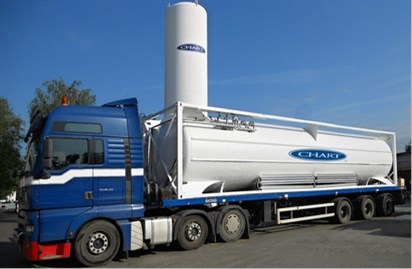EIA: Containerized LNG broadens reach of natural gas to off-grid customers

Photo courtesy of Chart Industries and the US Energy Information Administration.
Earlier this month, NuBlu Energy started construction on the first of three trains of a small-scale LNG plant along the Mississippi River in Port Allen, Louisiana. This project is designed to serve the domestic natural gas off-grid market – natural gas consumers not connected to the natural gas pipeline grid.
For many remote markets across the United States, including Hawaii and parts of Alaska, LNG is becoming a more viable option for potential off-grid consumers currently using other fuels. Although waterborne trade in LNG via large ocean-going vessels has been a fixture of the global gas market since 1959, more recently there has also been an expanding demand for moving LNG to low-volume markets, including LNG for marine engine refueling, power generation, the containerized market, and for oil and natural gas production.
Increasingly, LNG is being transported to customers in ISO containers, which provide a flexible means of delivery, particularly to off-grid customers. Examples of this include the recent delivery of containerized LNG to Hawaii, and similar projects serving the Caribbean basin's power generation markets.
Unlike the delivery of LNG by tanker, which requires open-water access and large on-shore infrastructure, or by truck, which requires dedicated vehicles or fleets capable of carrying LNG, ISO containers can utilize existing inter-modal infrastructure. The 40–foot by 8–foot by 8–foot containers fit on any rail car, truck trailer, or container ship capable of carrying standard shipping containers. Each container can store up to 10,000 gal, which is the gaseous equivalent of 830 Mcf, the average annual consumption of 13 American households according to EIA's 2009 Residential Energy Consumption Survey.
ISO containers are capable of storing LNG in cryogenic state for up to 75 days, providing enough time for the cargo to reach its destinations and to serve as a viable means of storage. With a portable vaporizer, which can typically re-gasify 90 Mcf per hour, the LNG can be delivered as pipeline-quality natural gas to consumers.

- ExxonMobil halts 1-Bft3d blue hydrogen project in Texas
- Aramco and Yokogawa commission multiple autonomous control AI agents at Fadhili gas plant
- Ukraine will resume gas imports via Transbalkan route in November
- Mitsubishi to inject $260 MM into Brunei LNG project
- Freeport LNG (U.S.) on track to take in more natgas on Thursday after unit outage



Comments